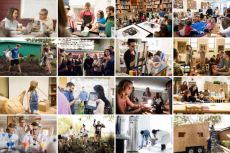Cool Class: Foundations in Sculpture
October 21, 2015
By Rob Humphreys ’16MBA

Connecting with their inner spirit animals, first-year students take a creative, hands-on approach to learning the foundations of a time-honored art form.
During the Renaissance, an artist’s three-dimensional creation (think Michelangelo’s David) was judged largely on technical qualities such as proportion, beauty, and life-like resemblance.
Today, sculpture is often a more abstract vehicle, an exploration into the very ideas and concepts that fuel individual expression.
Through a series of studio assignments, first-year students in this Rollins College Conference (RCC) course are encouraged to develop their own sculptural vocabulary and a repertoire of practical techniques. Using their new skills to parade around as “spirit animals” is a fun bonus.
Course Title
Foundations in Sculpture: Constructing Meaning

Instructor
Joshua Almond, associate professor of studio art

The Scoop
Students learn the fundamentals of sculpture with a hands-on approach that emphasizes spatial awareness, problem solving, and conceptual development. Allegory, metaphor, and symbolism are just as important as tools, materials, and techniques.
By focusing on conceptual development, students begin to think about the content of their work in a more sophisticated manner,” Almond says. “In addition, they realize they’re going to be pushed way outside their comfort zone and use materials—like wood and metal—that are intimidating and/or unfamiliar.”

Snapshot
When we dropped in on the class September 28, students were modeling and showcasing their spirit animals. Made using cardboard, the wearable sculptures enabled them to explore identity and a three-dimensional form in space using a medium that doesn’t require a tremendous amount of skill to manipulate.
“The sculpture itself was going to transform their physical being in a new and interesting way,” Almond says. “We talked about how the assignment connects to various traditions and societies around the world where costumes are worn for spiritual or ritualistic purposes, and we used the idea of a spirit animal as a departure point.”

Student Perspective
Meredith Ewen ’19, who plans to major in art history, says the class has challenged her to explore new materials and concepts.

“These materials, while simple at first glance, have exposed me to the challenge of how to understand the ways the material or process is limited and how to then find ways to manipulate them to fit my design,” she says. “Overall, this class has taught me lessons of understanding and flexibility that transcend out of the studio space and into other realms of my college experience as I study and engage in the community.”

Fun Fact
Native American totem poles are a natural example of how sculpture intersects with “spirit animal” iconography. According to New World Encyclopedia, designs featuring bears, birds, frogs, lizards, and people—often endowed with arms, legs, and wings—were carved to illustrate stories, commemorate historic persons, represent shamanic powers, and provide objects of public ridicule.

Related News
September 10, 2025
Zhang Publishes Essay on the History of Asian Americans in Florida
Professor Wenxian Zhang has published a new scholarly essay on Asian American history in Florida in the summer issue of Phylon: The Clark Atlanta University Review of Race and Culture.
September 10, 2025
Haddad Publishes New Edition of Business Statistics Textbook
Serina Haddad has published a 4th edition of her Business Statistics textbook.
September 10, 2025
Photos: Welcome Week 2025
The 2025-26 academic year has officially begun. From move-in to SPARC Day, relive the best moments from Welcome Week.
